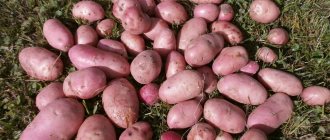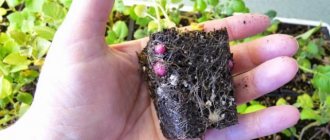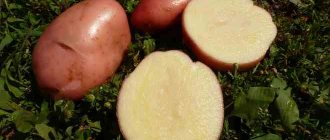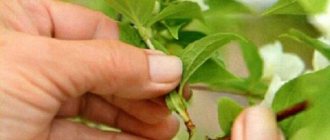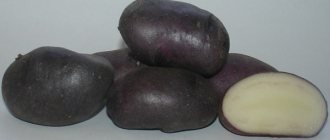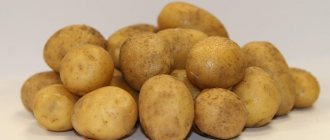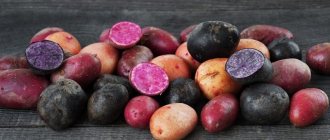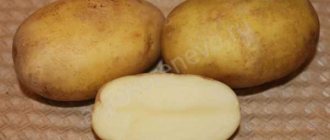Late-ripening potato varieties
Basically, late potato varieties are planted in the south of Russia, where it is warm in September and May, since such potatoes have a rather long growing season. It can take 95–140 days from the first shoots to harvest.
- mid-late potato varieties;
- late.
Late-ripening potato varieties are harvested 110–140 days after sprouting. While the mid-late ones have a growing season of 95–110 days.
Peculiarities
Characteristics of late varieties:
- At the very base of the stem the bushes branch strongly.
- Tuber vegetables contain quite a lot of useful substances and carbohydrates; the prepared food is very filling and tasty.
- These potatoes contain 12-20% starch, which means that the tubers boil well, but at the same time retain their shape if they are placed in soup.
- Potatoes last the longest; they can last until the summer season and still be marketable and have excellent taste.
- Since potatoes have a long growing season, they are susceptible to various diseases, such as late blight and scab. Because of this, when choosing a variety, you need to choose one that has good immunity to diseases, and also do not forget to regularly treat the bushes for prevention.
- Tubers are dug up in dry weather, without rain, since there should be no soil on them, otherwise they will not be stored.
Harvest and storage
The Alouette variety is usually grown for long-term storage. It retains its presentation and taste for quite a long time due to its high shelf life.
Potatoes are stored in a dark and dry place
After digging, the potatoes are laid out in an even layer in the fresh air to dry. In this case, the tubers should be protected from sunlight. Dried tubers are placed in boxes and stored in a dry, cool and dark room.
Mid-late varieties
It was selected in Holland, but is well adapted for cultivation in the Far East and the Middle Volga region. It was included in the State Register of Breeding Achievements of Russia in 1998. The bushes are up to 80 cm high, straight, not branched. The leaves are medium and large. The inflorescences are reddish-violet. From the formation of the first sprouts to harvest, about 110–120 days pass.
The tubers are oval in shape and red in color. The weight of one tuber is 63–109 g, the taste is excellent. French fries and chips are made from potatoes.
High-yielding potatoes - harvested at 300 c/ha. 2 kg of crop is dug from one bush. The culture is immune to fusarium, golden nematode, cancer, scab, and late blight.
It was bred in Belarus. Included in the State Register of Breeding Achievements of Russia in 2002. Vetraz is considered a benchmark, a standard for comparison with other varieties.
The bushes are tall. Leaves are medium sized. The inflorescences are white. Collected at 179–285 c/ha. The tubers are oval-round, yellowish. Potato weight 94–156 g, taste excellent. The presence of starch averages 15.4–19.1%.
Windgrass is immune to cancer, banded mosaic, nematode, and leaf curl. Moderately susceptible to late blight.
Vitelotte was developed in France. The growing season is up to 110 days. The tubers are elongated. They have a very dark blue color. Potato weight is 70–100 g. If you cut a potato, you will see blue-violet flesh. Consumption of this variety lowers blood pressure. Tubers contain more antioxidants than those with regular yellow flesh. They can be stored for a long time.
Unfortunately, Vitelotte also has disadvantages. It is not resistant to scab and late blight.
The variety was bred in Belarus and was included in the State Register of Russia in 2005. 100–114 days pass from germination to harvest.
Plants are up to 60 cm high, quite branched, flowers are purple-red. The tubers are red, somewhat rough, weighing 89–139 g. The pulp is cream-colored.
The yields are high, approximately 177–242 c/ha. 16 tubers are collected from each bush.
The bushes tolerate sudden changes in temperature, high and low temperatures well. They are resistant to nematodes, cancer, scab, and blackleg. But there is also a minus - susceptibility to late blight, which is a fungal disease. It can be detected by a whitish coating on the lower part of the foliage and dark brown spots on the upper side of the leaves. To eliminate the disease, spray the tops with Bordeaux mixture, dilute 100 g of copper sulfate and 100 g of lime in a bucket of clean water (10 l).
The oldest variety. Included in the State Register of Breeding Achievements of Russia back in 1930. Suitable for cultivation in the south and center of Russia.
Bushes up to 0.8 m high, straight, purple-red inflorescences. The tubers are pale beige. The weight of one tuber is 90–120 g.
Up to 15 tubers are collected from 1 bush. Lorch has a high yield, harvested at 250–350 c/g. The taste of the tubers is excellent. The presence of starch is 15–20%. Tubers can be stored until the next season without loss of taste and nutritional value. Plants are not affected by bacteriosis or various viral diseases. But they are susceptible to late blight on leaves and tops.
Article on the topic: Potato variety “Ilyinsky” - description and photo
Disadvantage - the bushes cannot tolerate the lack of rain and heat, they need to be watered.
Included in the State Register of Breeding Achievements of Russia in 2004. Tall bushes. The inflorescences are reddish-violet. The tubers are reddish. Tuber weight 77–102 g. The pulp is white, of excellent taste. Potatoes store well and are transportable. They collect 117–198 quintals per hectare.
Bushes are immune to cancer. Moderately resistant to nematodes and late blight.
Saturna is grown on an industrial scale. Alcohol and starch are made from tubers. The bushes are tall, the inflorescences are snow-white. Saturna was included in the State Register of Breeding Achievements of Russia in 2005.
The tubers are oval, yellowish, rough, the flesh is also yellow. They are well preserved and easy to transport. The presence of starch is up to 21%. Tuber weight 90–114 g.
Productivity 155–246 c/ha. The bushes are immune to golden nematode and cancer. Moderately susceptible to late blight.
Included in the State Register of Breeding Achievements of Russia in 2005. The weight of one tuber is 89–125 g. Its color is yellow, the flesh is creamy, and the taste is excellent.
The use is universal, you can boil potatoes, put them in soups, make casseroles, and purees. The presence of starch is low 12.2–15.3%.
Up to 11 tubers are collected from a bush. Harvest quantity – 454 c/ha.
The bushes are immune to cancer and golden nematode. Moderately resistant to late blight.
Violet
This is a new variety. It was included in the State Register of Breeding Achievements of Russia only in 2014.
The bushes are medium in height, semi-erect. The leaves are large. The variety has blue oval-round tubers, and the flesh is also blue. They collect 60–209 quintals per hectare. With good care, you can harvest up to 221 centners per hectare, but this is still lower than the yield of the Versal variety, which is accepted as the standard. The tubers are small, weighing 69–80 g per one. The presence of starch is 10.5–14.4%.
The variety is immune to cancer and more or less resistant to late blight. But it is affected by the golden nematode.
Late potato varieties, photos and descriptions
Atlant was developed in Belarus. Included in the State Register of Russia in 2002. Growing season 100–120 days.
The tubers are yellowish; the potatoes are distinguished by a thick yellow skin and dense creamy pulp. The potato tastes great. Used for preparing a variety of dishes.
The shape of the tubers is round-oval. Tuber weight 90–119 g. High starch content 16.8–22.6%. Harvest up to 260 c/ha. The variety is resistant to nematode and cancer, as well as wrinkled, striped mosaic, leaf curl. Potatoes are moderately susceptible to late blight.
Zarnitsa was selected in Belarus. The growing season is 120–140 days.
The bushes are 60 cm high, the inflorescences are reddish-purple. The tubers are red, the weight of one tuber is approximately 120 g. 15 tubers are collected from a bush. Productivity is high, harvesting up to 500 c/ha.
Grows in almost any soil. The bushes easily tolerate drought. They are resistant to blackleg, nematode, and cancer. But there are also disadvantages - instability to late blight and other fungal diseases.
Zdabytak was developed in Belarus. It was included in the State Register of Russia in 2005. The growing season is 120–140 days.
The bushes are medium in height, the inflorescences have a traditional red-violet hue. The tubers are reddish, slightly rough, weighing 101–128 g. 15 potatoes are collected from each bush, and 211–298 centners per hectare. Starch content 19.2–25.4%. Because of this, mashed potatoes and casseroles are made from tubers. The variety is immune to cancer, weakly affected by nematodes, and moderately resistant to late blight.
The variety was included in the State Register of Breeding Achievements in 2005.
The inflorescences are snow-white. The tubers are round-oval in shape, yellowish, when cut, the creamy flesh and pink eyes are visible. You can collect 193–315 quintals per hectare. But with proper care, you can achieve a yield of 321 centners per hectare. The weight of the potato is 75–126 g. The presence of starch is 7.9–13.5%, which is less than that of standard potatoes.
The bushes are immune to golden nematode and cancer. But there is a drawback - instability to late blight.
Secrets of growing late potato varieties
Before planting, holes are dug at a distance of 25–30 cm from each other. No more than 5–6 bushes are planted per 1 m². The distance between rows should be at least 0.7 m.
A good harvest when planting late potato varieties is harvested by planting the tubers in high beds. They make wooden boxes 1.4 m wide, 6 m long and half a meter high. During the season, the beds are loosened once, hilled up twice, and fertilized twice.
Both early and late ripening potato varieties can be planted on one plot.
It is best to plant late varieties in the south. But in the center of Russia, potatoes may be subject to returning frosts in the spring or there will be rainy weather in the fall, and this will affect the harvest. If you dare to plant late potatoes while living in the northern regions of Russia, then you will definitely need to germinate the tubers.
Article on the topic: Potato variety “Malamur” - description and photo
Potato variety Lasunok
Lasunok is one of the best varieties of mid-late potato, which is distinguished by very large tubers, which together bring a good harvest. The variety was brought to our country from Belarus and quickly became “our family” thanks to its very high taste and long-term storage. The ripening period is 80-120 days. Due to the fact that the tops have a powerful root system, spreading branches and tough foliage, the tubers are formed of a gigantic size, like for potatoes, with a weight of 160-200 grams, and this is a very high figure, especially since despite the huge size of the tubers in the bush there are 11-12 pieces or more, which automatically makes the Lasunok variety a leader in yield. The tubers have a regular round shape with slight elongation and moderate eyes. The peel has a beautiful light yellow tint, but the flesh is rich beige. To obtain the maximum yield, you need to plant potatoes at the end of April or at the beginning of May at a distance from each other of no less than 60-70 cm, and immerse them 7-10 cm deep. Minimal care and proper planting guarantee an excellent harvest.
Main potato varieties: description and characteristics
Choosing the right type will help you get a good potato harvest that will last throughout the winter. Most gardeners are guided only by the ripening period, but in fact they need to choose it based on other indicators:
- Climatic conditions are very important in the growing process. For example, drought-resistant species are selected for the southern regions, and species that tolerate frost well are selected for the northern regions.
- The starch content affects the nutritional quality. Instances with a high starch content easily soften when cooked, while types with low starch levels retain their shape.
- Resistance to diseases , especially viral ones, also plays an important role. It is better to choose hybrids that are resistant to late blight and other diseases, since failure to comply with this condition can lead to the loss of more than part of the crop.
According to the ripening period, they are divided into ultra-early (ripen a month after planting), early (harvesting begins after 40-50 days), mid-ripening (the cultivation period is approximately 2-2.5 months) and late (ripen 80-100 days after disembarkation). It is recommended to plant several species at once in order to receive a harvest all summer and save enough for the winter.
Potato variety Zdabytak
Zdabytak is a truly Belarusian variety of late potato that ripens in 120-130 days. For maximum yield, sowing work must be carried out in May with strict adherence to the planting scheme: the distance between plants should be 65-70 cm, and 40 cm between rows is enough. Tubers should be immersed 10 cm deep. With such planting, you can count on a good harvest with the weight of one tuber – 100-130 grams. The shape of the tubers is regular, even and oval. The color of the peel is beautiful, pink, and the pulp is snow-white. The presence of not deep, small eyes cannot please anyone. Excellent taste and excellent presentation ensure not only the popularity of the variety, but also competitiveness.
Early potato varieties - photos and descriptions
Early ripening crops are valued because they can be harvested in early summer. But it is important to consider that they are not suitable for long-term storage, since the fruits quickly deteriorate indoors.
Early hybrids are in high demand among gardeners, as they are characterized by high early maturity and allow you to enjoy fresh home-grown potatoes at the beginning of summer. Let's take a closer look at the most popular early types.
Potato Riviera: characteristics
The value of the crop is that tubers on the bushes begin to form very early, even before late blight can damage the plant. But these are not all the advantages.
Figure 1. Early hybrid Riviera
Characteristics of the hybrid can also be considered high yield and taste. The fruits have a regular oval shape and smooth skin, and are not damaged during transportation (Figure 1).
Note: Due to its high early maturity, Riviera is very popular in the southern regions. In warm climates, two harvests can be harvested per season.
On average, up to 12 fruits can be collected from one bush. The pulp is a pleasant yellow color, softens quickly when cooked and has a pleasant taste. It is resistant to major diseases and pests, but if cultivation technology and planting timing are violated, it can be damaged by late blight and scab.
An overview of the Riviera hybrid is given in the video.
Impala is a popular species that produces early, tasty, large tubers. Its yield is practically independent of climate and weather conditions. In both rainy and dry summers, up to 13 fruits can be collected from one bush (Figure 2).
Figure 2. Impala Potato
The vegetables are light yellow, oval, with a smooth skin and a small number of eyes. It boils well when cooked, and the bushes are resistant to cancer, nematodes and infections. However, plants can be affected by late blight and mosaic, so it is recommended to treat the planting material before planting.
Potato Alouette - description of the variety
This variety of Dutch selection is loved by many gardeners. By following the usual agricultural techniques for growing potatoes, it is often possible to obtain high yields.
The characteristics of this variety are determined by a number of parameters.
- Ripening period and yield. Tubers ripen in 70-80 days. From each square meter of plot you can get up to 4-5 or more kilograms of harvest.
- Disease resistance. High resistance to cancer, nematode and late blight was noted.
- Characteristics of tubers. The oblong tubers have a pink skin and yellow flesh. Tuber weight is from 97 to 125 g.
Alouette is a very productive variety
- Appearance. Bush of medium height, erect. Leaf size varies from medium to large.
- Demanding climate. It is characterized by average resistance to climatic conditions. The most favorable region for cultivation is the Volga-Vyatka region.
- Taste qualities. Root vegetables have a pleasant sweetish taste. The variety is suitable for preparing various dishes.
This is interesting! Potatoes are considered a perennial crop, but in reality they are planted and harvested every season, exclusively as an annual plant.
Mid-season species
Mid-season potatoes begin to be dug up in mid-summer. But if planting is late, harvesting can be carried out in August. Most of these hybrids were bred by breeders, and therefore are resistant to viruses and fungi.
The harvest of mid-season hybrids is well stored, and the dense pulp and smooth peel are not damaged during transportation.
A distinctive feature is its good adaptation to any growing conditions. The only exception is high humidity. Under such conditions, the fruits become small, but do not change their taste (Figure 3).
Figure 3. Lugovskaya view
The vegetable tolerates heat and drought well, is resistant to late blight, and the tubers are distinguished by high taste. Compared to other species, it has a longer growing season, and the fruits in the bushes are predominantly small and medium in size.
Belongings: characteristics
Potatoes are table salad types. It was bred in Belarus, and gardeners value it for its high yield and taste (Figure 4).
Figure 4. Mid-season potatoes Scarb
The height of the bush is average, but when harvesting from one plant you can get many fruits of a perfect, even oval shape and almost the same average size. The taste qualities are valuable because it retains its shape well and does not darken when cooked, and the skin of the vegetable is smooth with a minimum number of eyes.
Related article: Purple potato varieties: names, cultivation, cooking
The only drawback can be considered the susceptibility of the stems to late blight, but even in the presence of infection, the vegetables do not spoil. Other diseases and pests practically do not affect the vegetable.
Late varieties
Late-type potatoes are grown primarily for winter storage. A long growing season implies careful processing of the bushes during cultivation. The soil around them needs to be regularly loosened and freed from weeds, as well as hilled. It is better to carry out the procedure several times a season so that the plants can more actively develop the root system and produce more fruits.
Late species that are best suited for growing at home are listed below.
Zarnitsa: description
The late Zarnitsa type is distinguished by medium-sized tubers. They are oval, with small eyes and light red skin and light yellow flesh (Figure 5).
Figure 5. Potato Zarnitsa
Vegetables are resistant to mechanical damage and have good shelf life. Thanks to their dense pulp, potatoes are great for salads, freezing and making fries.
Zarnitsa bushes sprout evenly, and although the tops are not too tall, up to 16 tubers can be collected from one bush. An additional advantage is resistance to diseases and pests.
The elongated fruits have a dense yellow skin, which prevents damage to the tubers during harvesting, storage and transportation (Figure 6).
Figure 6. Vegetables of the Atlant species
The pulp contains quite a lot of starch, but at the same time it has high taste qualities. Therefore, vegetables are suitable for consumption, processing and animal feeding. In addition, the hybrid is resistant to nematodes and other pests, as well as major crop diseases.
The author of the video talks in detail about the main varieties of potatoes and their characteristics.
Potato variety Saturn
Saturn is one of the best varieties of late potatoes with a regular round shape, imported from Holland. The ripening period is 110-120 days. During this period, medium-sized tubers are formed with a weight of 100-120 grams and a moderate amount in the bush - 7-10 pieces, but thanks to its excellent taste and long-term storage, the variety is very popular in Ukraine. External and internal data are similar, since both the pulp and the peel have a yellow tint. There is a lot of starch in the composition, often exceeding 21%. For the best harvest, tubers should be planted at a distance of 70 cm, and between rows should be kept at 35 cm. Use in any dishes indicates the versatility of this variety.
